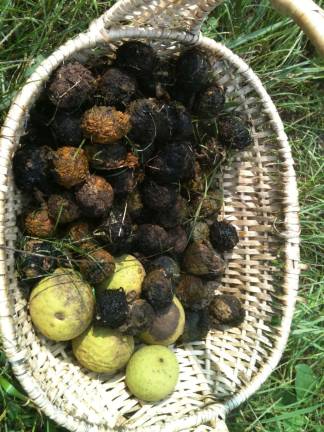Get your macros while you can

In the world of wild food, it’s easy to find micronutrients: the vitamins and minerals we mostly hear about. What are very hard to find and gather in any significant abundance are the three macronutrients: fat, protein, and carbohydrates. Since these major nutrition sources are so easily available at the grocery store, most of us hardly contemplate how hard they are to come by in the wild. Even during the short window when little fat-and-protein packets are falling out of the sky onto our cars, we rake them up, put them in the garbage, and head to the grocery store to buy walnuts from who knows where. In the Northeast, a forager has only a few months for collecting – and processing and storing – wild nuts, from September to December. Otherwise it’s back to the grocery store you go, while the convenience to do so lasts. Here’s how to unleash the walnut from inside those tennis ball looking things in your yard. Like all nuts, the black walnut has three layers: the hull, shell, and nutmeat. When green, the black walnut hull is a digestive bitter and antiparasitic, and can be harvested, dried and powdered, or — easiest of all — tinctured in alcohol using organic vodka. (Place walnuts or walnut hulls in jar, cover with alcohol, let steep four to six weeks, strain out nuts.) To harvest the nuts, I have designed a patented black walnut stomping technique. Okay, maybe the cavemen beat me to it, but it’s simple and efficient. When you find that walnut hulls are about half black and half green, kick and roll them with your heel until the hull opens, and the nut and shell roll out. Pick the nuts in shell out with your fingers, and put them in a bucket. Just try to use the tips of your fingers if you don’t want your hands to get stained. Lay the nuts in shell out on a tarp or somewhere you don’t mind getting a bit stained, and let them dry. Once dry, they don’t stain. In the shell, walnuts last years, unless there are any cracks in the shells that let air get in. To get the nutmeat out of the shell, you can buy a walnut cracker, or any wooden or rubber mallet works. If you use metal or rocks, the nut will often smash into oblivion. It’s helpful to use a nutpick or lobster pick, or even an unbent paperclip, to scrape out the nutmeat. My favorite way of preserving the nuts is to store them in an airtight jar, or smother them in raw local honey in a jar. This makes a great and healthy dessert. You can also grind walnuts into flour, and work it into any bread or pancake recipe for a unique flavor and nutrient packed addition. Dan de Lion